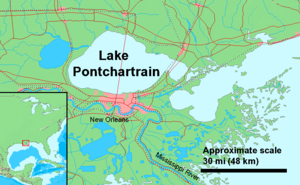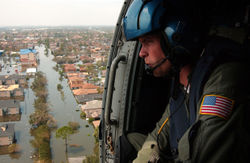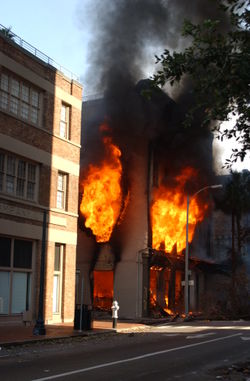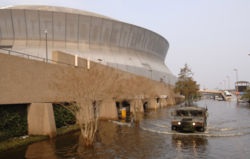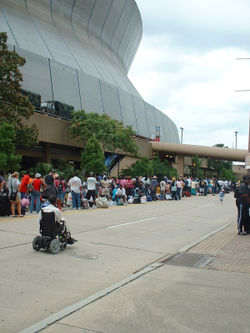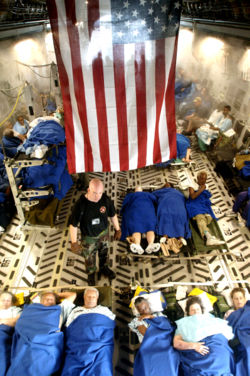Effect of Hurricane Katrina on New Orleans
2007 Schools Wikipedia Selection. Related subjects: Natural Disasters
| Hurricane Katrina |
|
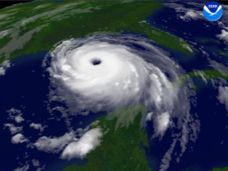 |
|
|
General
Impact
Relief
Analysis
Other wikis
|
|
The effect of Hurricane Katrina on New Orleans was catastrophic and long-lasting. The storm, which was the costliest hurricane as well as one of the deadliest natural disasters in U.S. history, made its second and third landfalls in the Gulf Coast region on August 29, 2005 as a powerful Category 3 hurricane (with a storm surge of a Category 5 hurricane). By August 31, 2005, eighty percent (80%) of the city was flooded, with some parts under 20 feet (6.1 meters) of water. Four of the city's protective levees were breached, including the 17th Street Canal levee, the Industrial Canal levee, and the London Avenue Canal floodwall.
Although more than 80% of residents evacuated, the rest remained. The Louisiana Superdome, used as a designated "refuge of last resort" for those who remained in the city, also sustained significant damage, including two sections of the roof that were compromised, and the dome's waterproof membrane had essentially been peeled off. As the city flooded, many who remained in their homes had to swim for their lives, wade through deep water, or remain trapped in their attics or on their rooftops.
The disaster had major implications for a large segment of the population, economy and politics of the entire United States, which lasted for several months, well into 2006.
Background
Flooding due to rain and storms has long been an issue since the New Orleans' early settlement due to the city's location on a delta marsh, much of which sits below sea level. The city is surrounded by the Mississippi River to the south, Lake Pontchartrain to the north, and Lake Borgne to the east. The first settlements by the French during colonial times in the area were above sea level, a trend that continued until the 19th century. Construction of the levees along the River began soon after the city was founded, and more extensive river levees were built as the city grew. The levees were originally designed to prevent damage caused by seasonal flooding. Today, the modern 17th Street and London Avenue Canals are used for drainage, while the wide, navigable Industrial Canal is used for shipping. The heavy flooding caused by Hurricane Betsy in 1965 brought concerns regarding flooding from hurricanes to the forefront.
There were many predictions of hurricane risk in New Orleans before Hurricane Katrina in August, 2005. In 2001, the Houston Chronicle published a story which predicted that a severe hurricane striking New Orleans, "would strand 250,000 people or more, and probably kill one of 10 left behind as the city drowned under 20 feet of water. Thousands of refugees could land in Houston." Many concerns also focused around the fact that the city's levee system was only designed for hurricanes of no greater intensity than category 3. As it turned out, Katrina was Category 3 when it made landfall and most of New Orleans experienced Category 1 or 2 strength winds. However, due to the slow moving nature of the storm in its pass over New Orleans, several floodwalls lining the shipping and drainage canals in New Orleans collapsed and the resulting flood water from Lake Ponchartrain inundated the city within the two days following the storm, causing costly damage to buildings and resulting in many deaths.
Furthermore, the region's natural defenses, the surrounding marshland and the barrier islands, have been dwindling in recent years. Much of the land was undeveloped swamp on the lake side, and only small levees were constructed in the 19th century. A much larger project to build up levees along the lake and extend the shoreline out by dredging began in 1927. As the city grew, there was increased pressure to urbanize lower areas, and, as a result, a large system of canals and pumps was constructed to drain the city. Drainage of the formerly swampy ground allowed more room for the city to expand, but also resulted in subsidence of the local soil.
Outside of the city, the Mississippi River's natural deposition of suspended sediment built up the river's delta marshlands during periodic flooding episodes. However, the lower Mississippi was later restricted to channels for the benefit of shipping, which interrupted the process that continued to build the Mississippi Delta and prevented its erosion. As the swampy lands of Southern Louisiana shrank, the land began to sink. Entire barrier islands disappeared during periodic storms as the land of the vast delta slowly settled without river silt to replenish the wetlands. Approximately one-third of the land subsidence has been attributed to the large number of canals through the delta. Barge traffic and tides erode the earth around the edge of the canals, and salty Gulf water seeps in along them, slowly salinating the ground and killing the vegetation that the land previously depended on to anchor it.
Pre-Katrina Preparations
The eye of Hurricane Katrina was forecast to pass to the east of New Orleans. In that event, the wind would come back from the north as the storm passed, forcing large volumes of water from Lake Pontchartrain against the levees and possibly into the city. It was also forecast that the storm surge in Lake Pontchartrain would reach 14 to 18 feet (4 - 5 meters), with waves reaching seven feet (2 meters) above the storm surge.
On August 28, at 10:00 AM CDT, the National Weather Service (NWS) field office in New Orleans issued a bulletin predicting catastrophic damage to New Orleans. Anticipated effects included, at the very least, the partial destruction of half of the well-constructed houses in the city, severe damage to most industrial buildings, rendering them inoperable, the "total destruction" of all wood-framed low-rise apartment buildings, all windows blowing out in high-rise office buildings, and the creation of a huge debris field of trees, telephone poles, cars, and collapsed buildings. Lack of clean water was predicted to "make human suffering incredible by modern standards".
It was also predicted that the standing water caused by the storm surge would render most of the city uninhabitable for weeks and that the destruction of oil and petrochemical refineries in the surrounding area would spill waste into the flooding. The resulting mess would coat every surface, converting the city into a toxic marsh until water could be drained. Some experts said that it could take six months or longer to pump all the water out of the city.
Evacuation order
In anticipation of widespread destruction caused by Hurricane Katrina, Max Mayfield, the director of the National Hurricane Centre, telephoned New Orleans Mayor Ray Nagin on the night of August 27 to express his extreme concern, and on the following day, made a video call to U.S. President George W. Bush at his farm in Crawford, Texas about the severity of the storm.
With the hurricane threatening the Gulf Coast, many New Orleans residents started taking precautions to secure their homes and prepare for possible evacuation on Friday the 26th and Saturday the 27th. By mid morning on the 27th, many local gas stations which were not yet out of gas had long lines. Nagin first called for a voluntary evacuation of the city at 5:00 PM on August 27 and subsequently ordered a citywide mandatory evacuation at 9:30 AM on August 28, the first such order in the city's history. In a live news conference, Mayor Nagin predicted that, "the storm surge most likely will topple our levee system," and warned that oil production in the Gulf of Mexico would be shut down. President Bush made a televised appeal for residents to heed the evacuation orders, warning, "We cannot stress enough the danger this hurricane poses to Gulf Coast communities." Many neighboring areas and parishes also called for evacuations. By mid-afternoon, officials in Plaquemines, St. Bernard, St. Charles, Lafourche, Terrebonne, Jefferson, St. Tammany, and Washington parishes had called for voluntary or mandatory evacuations."
Although Mayor Ray Nagin ordered a mandatory evacuation of the city, many remained voluntarily, which a CNN writer described as "gambling with their own lives." Reasons were numerous, including feeling their homes or the buildings they planned to stay in offered sufficient protection, lack of financial resources or access to transportation, a feeling of obligation to protect their property, or fearing that the tribulations of evacuation (which many went through the previous year with Ivan) were more of a hazard than the hurricane risk. A "refuge of last resort" was designated at the Louisiana Superdome. Beginning at noon on August 28 and running for several hours, city buses were redeployed to shuttle local residents from 12 pickup points throughout the city to the "shelters of last resort." Several hundred school buses were also available, yet they were not deployed, apparently because not enough drivers could be found.
By the time Hurricane Katrina came ashore early the next morning, approximately one million people had fled the city and its surrounding suburbs by the evening of August 28, while about 20,000 to 25,000 people remained in the city, taking shelter at the Louisiana Superdome, along with 550 National Guard troops. While supplies of MREs and bottled water were available at the Superdome, Nagin told survivors to bring blankets and enough food for several days, warning that it would be a very uncomfortable place. As the elevation of the Superdome is about three feet (1 m) above sea level, the forecasted storm surge was predicted to cause flooding on that site. Survivors were told to keep out of the lower levels of the structure, for fear it would be flooded.
The Superdome had been used as a shelter in the past, such as during 1998's Hurricane Georges, because it was estimated to be able to withstand winds of up to 200 mph (320 km/h) and water levels of 35 feet (10 m).
The entire southeastern Louisiana region was declared a disaster area by the Federal Government before Hurricane Katrina made landfall, and FEMA prepositioned 18 disaster medical teams, medical supplies and equipment, urban search and rescue teams along with millions of MREs, liters of water, tarpaulins, and truckloads of ice.
Effects
Hurricane Katrina made its second and third landfalls in the Gulf Coast region on August 29, 2005 as a Category 3 hurricane.
On Monday August 29 area affiliates of local television station WDSU reported New Orleans was experiencing widespread flooding due to several levee breaches, was without power, and that there were several instances of catastrophic damage in residential and business areas. Entire neighborhoods on the south shore of Lake Pontchartrain were flooded.
The extensive flooding stranded many residents, who remained long after Hurricane Katrina had passed. Stranded survivors dotted the tops of houses citywide. In the Ninth Ward, as many as 116 residents were seen on rooftops seeking aid. Some were trapped inside attics, unable to escape.
Some people reportedly chopped their way onto their roofs with hatchets and sledge hammers, which residents had been urged to keep in their attics in case of such events since Hurricane Betsy. Clean water was unavailable, and power outages were expected to last for weeks.
By 11:00 PM on August 29, Mayor Nagin described the loss of life as "significant" with reports of bodies floating on the water throughout the city, though primarily in the eastern portions. He also said many houses have been picked up and moved. There was no clean water or electricity in the city, and some hotels and hospitals reported diesel fuel shortages. The National Guard began setting up temporary morgues in select locations.
Communications failures
Coordination of rescue efforts August 29 and August 30 were made difficult by disruption of the communications infrastructure. Many telephones, Internet access, including most cell phones, were not working due to line breaks, destruction of base stations, or power failures, even though some base stations had their own back-up generators. In a number of cases, reporters were asked to brief public officials on the conditions in areas where information was not reaching them any other way.
All local television stations were disrupted. Local television stations, and newspapers, moved quickly to sister locations in nearby cities. Broadcasting and publishing on the Internet became an important means of distributing information to evacuees and the rest of the world.
Amateur radio provided tactical and emergency communications and handled health-and-welfare enquiries.
By September 4, a temporary communications hub was set up at the Hyatt Hotel in downtown New Orleans.
Damage to buildings and roads
Most of the major roads traveling into and out of the city were damaged. The only route out of the city was west on the Crescent City Connection as the I-10 Twin Span Bridge traveling east towards Slidell, Louisiana had collapsed. The 24 mile long Lake Pontchartrain Causeway escaped unscathed but was only carrying emergency traffic. Louis Armstrong New Orleans International Airport was closed before the storm but thankfully reported no flooding in airplane movement areas or inside of the building itself. By August 30, it was reopened to humanitarian and rescue operations. Commercial cargo flights resumed on September 10, and commercial passenger service resumed on September 13.
On August 29, at 7:40 AM CDT, it was reported that most of the windows on the north side of the Hyatt Regency New Orleans had been blown out, and many other high rise buildings had extensive window damage. The Hyatt was the most severely damaged hotel in the city, with beds reported to be flying out of the windows. Insulation tubes were exposed as the hotel's glass exterior was completely sheared off.
The Superdome sustained significant damage, including two sections of the roof that were compromised, and the dome's waterproof membrane had essentially been peeled off. On August 30, Louisiana governor Kathleen Blanco ordered the complete evacuation of the remaining people that sought shelter in the Superdome. They were then transported to the Astrodome in Houston, Texas.
Levee failures
As of mid-day Monday, August 29, the eye of Hurricane Katrina had swept northeast. It subjected the city to hurricane conditions for hours, but spared New Orleans the worst brunt of the storm. Most buildings in Louisiana though flooded were spared direct impact of the powerful waves that communities along the beaches in Mississippi were subjected to. The City seemed to have escaped most of the catastrophic wind damage and heavy rain that had been predicted as a possibility. Damage, however was still very extensive, with windows and other debris blown out by heavy winds, and reports of widespread flooding and wind damage in the east of the city. But most buildings came through well structurally.
Unfortunately, the heavy winds and storm surges had severely weakened the city's levee system, and there were reports of extensive failures of the levees and flood walls protecting New Orleans, Louisiana and surrounding communities. The Mississippi River Gulf Outlet ("MR-GO") breached its levees in approximately 20 places, flooding much of New Orleans East, most of Saint Bernard Parish and the East Bank of Plaquemines Parish. The major levee breaches in the city included breaches at the 17th Street Canal levee, the London Avenue Canal, and the wide, navigable Industrial Canal, which left approximately 80% of the city flooded. There were three major breaches at the Industrial Canal; one on the upper side near the junction with MR-GO, and two on the lower side along the Lower Ninth Ward, between Florida Avenue and Claiborne Avenue. The 17th Street Canal levee was breached on the lower (New Orleans West End) side inland from the Old Hammond Highway Bridge, and the London Avenue Canal breached in two places, on the upper side just back from Robert E. Lee Boulevard, and on the lower side a block in from the Mirabeau Avenue Bridge. Flooding from the breaches put the majority of the city under water for days, in many places for weeks.
In the aftermath of Hurricane Katrina, engineers investigated the possibility that a failure in the design, construction, or maintenance caused much of the flooding. Originally, it was speculated that the levees had been overtopped by the storm surge, however this was later found not to be the case. Some investigations pointed to the possibility of a weakening of the soil beneath the foundations of the flood walls due to storm water caused the ground to shift, which would indicate that a major design flaw made during the construction of the levees had been a major cause of the failures due to the storm.
Loss of life
As of May 19, 2006, the official number of deceased victims from Louisiana was 1,577. The first deaths were reported shortly before midnight on August 28, as three nursing home patients died during an evacuation to Baton Rouge, most likely due to dehydration.
On September 4, Mayor Nagin speculated that the death toll could rise as high as ten thousand after the clean-up was completed. Some survivors and evacuees reported seeing dead bodies lying in city streets and floating in still-flooded sections, especially in the east of the city. The advanced state of decomposition of many corpses, some of which were left in the water or sun for days before being collected, hindered efforts by coroners to identify many of the dead.
There were six deaths confirmed at the Superdome. Four of these were from natural causes, one was the result of a drug overdose, and one was a suicide. At the Convention Centre, four bodies were recovered. One out of these four is believed to be the result of a homicide. Body collection throughout the city began on approximately September 9. Prior to that date, the locations of corpses were recorded, but most were not retrieved. There was a focus on living residents who refuse to evacuate.
Aftermath
Civil disturbances
In the aftermath of Hurricane Katrina, looting, violence, and other criminal activity became serious problems. With most of the attention of the authorities focused on rescue efforts, the security in New Orleans degraded quickly. By August 30, looting had spread throughout the city, often in broad daylight and in the presence of police officers. "The looting is out of control. The French Quarter has been attacked," City Councilwoman Jackie Clarkson said. "We're using exhausted, scarce police to control looting when they should be used for search and rescue while we still have people on rooftops."
Incapacitated by the breakdown of transportation and communication, as well as overwhelmed in terms of numbers, police officers could do little to stop crime, and shopkeepers who remained behind were left to defend their property alone. Looters included gangs of armed gunmen, and gunfire was heard in parts of the city. Along with violent, armed robbery of non-essential valuable goods, many incidents were of residents simply gathering food, water and other essential commodities from unstaffed grocery stores. There were also reports of looting by some police officers. There was also significant looting reported continually in areas of the city with few, if any permanent residents, such as the Lakeview, Gentilly, and the Midcity regions.
" Sniper fire" was also reported throughout the city, targeted at rescue helicopters, relief workers, and police officers. One of the possibilities of the sniper fire was possibly resistance to relocation or evacuation. One report of violence involved police shooting six people on the Danziger Bridge, which carries the Chef Menteur Highway across the industrial canal, who were reportedly attacking contractors of the U.S. Army Corps of Engineers involved in the 17th Street Canal repair.
Looting and violence was also hampering efforts to evacuate the Tulane University medical centre, as well. Looters in boats with guns had attempted to break into the hospital but were repelled by hospital staff. "If we don't have the federal presence in New Orleans tonight at dark, it will no longer be safe to be there, hospital or no hospital," Acadian Ambulance Services C.E.O. Richard Zuschlag told CNN. Several news sources reported instances of fighting, theft, rape, and even murder in the Superdome and other refuge centers.
Most of the city's 750 nuns had remained in the city during the storm. They refused to leave, even after Governor Blanco had ordered everyone left after the storm evacuated, because it would have been the only time in over 200 years that the clergy had left the city in a time of suffering. Many government officials were very concerned about their safety.
Additional acts of unrest occurred following the storm, particularly with the New Orleans Police Department. In the aftermath, a tourist asked a police officer for assistance, and got the response, "Go to hell, it's every man for himself." Also, many New Orleans police officers deserted the city in the days before the storm, many of them escaping in their department-owned patrol cars. This added to the chaos by stretching law enforcement thin . Additionally, there were reports of police officers stealing vehicles from car dealerships, further adding to the confusion.
Regaining control
On August 31, New Orleans's 1,500-member police force was ordered to abandon search and rescue missions and turn their attention toward controlling the widespread looting. The city also ordered a mandatory curfew. Mayor Nagin called for increased federal assistance in a, "desperate S.O.S.," following the city's inability to control looting and was often misquoted as declaring martial law in the city, despite there being no such term in Louisiana state law (a declaration of a state of emergency was instead made). On the same day, Governor Kathleen Blanco announced the arrival of a military presence, stating that they, "[knew] how to shoot and kill and [expected that] they [would]." Despite the increased law enforcement presence, crime continued to be problematic. Several armed attacks on relief helicopters, bus convoys, and police officers were reported, and fires erupted around the city at stores and a chemical storage facility. By September 1, 6,500 National Guard troops had arrived in New Orleans, and on September 2, Blanco requested a total of 40,000 for assistance in evacuation and security efforts in Louisiana.
Some concern over the availability and readiness of the Louisiana National Guard to help stabilize the security situation was questioned. Guardsman Lieutenant Colonel Pete had commented that, "dozens of high water vehicles, humvees, refuelers, and generators were abroad." At the time of the hurricane, approximately 3,000 members of the Guard were serving a tour of duty in Iraq. With total personnel strength of 11,000, this meant that 27% of the Louisiana National Guard was away. However, both the White House and the Pentagon argued that the depletion of personnel and equipment did not impact the ability of the Guard to perform its mission — rather, impassable roads and flooded areas were the major factors impeding the Guardsmen from securing the situation in New Orleans.
Before Hurricane Katrina, the murder rate in New Orleans was ten times higher than the U.S. average. After the situation in New Orleans was brought under control, criminal activity in New Orleans dropped significantly.
The Superdome
As one of the largest structures in the city, evacuees were brought to the Superdome to wait out the storm or to await further evacuation. Many others made their way to the Superdome on their own, hoping to find food, water, shelter, or transport out of town. On August 29, Katrina passed over New Orleans with such force that it ripped two holes in the Superdome roof. On the evening of August 30, Maj. Gen. Bennett C. Landreneau, of the Louisiana National Guard, said that the number of people taking shelter in the Superdome had risen to around 15,000 to 20,000 as search and rescue teams brought more people to the Superdome from areas hard-hit by the flooding. As conditions worsened and flood waters continued to rise, on August 31, Governor Blanco ordered that all of New Orleans, including the Superdome, be evacuated. The area outside the Superdome was flooded to a depth of three feet (1 m), with a possibility of seven feet (2.3 m) if the area equalized with Lake Pontchartrain. Governor Blanco had the state send in 68 school buses on Monday to begin evacuating people.
Despite increasingly squalid conditions, the population inside continued to grow. The situation inside the building was described as chaotic; reports of fights, rape, and filthy living conditions were widespread. As many as 100 were reported to have died in the Superdome, with most deaths resulting from heat exhaustion, but other reported incidents included an accused rapist who was beaten to death by a crowd and an apparent suicide. Despite these reports, though, the final official death toll was significantly less: six people inside (4 of natural causes, one overdose, and an apparent suicide) and a few more in the general area outside the stadium.
FEMA had announced that, in conjunction with Greyhound, the National Guard, and Houston Metro, the 25,000 people at the Superdome would be relocated across state lines to the Houston Astrodome. Roughly 475 buses were promised by FEMA to ferry evacuees with the entire evacuation expected to take two days. By September 4, the Superdome had been completely evacuated.
Although the Superdome suffered damage by water and wind to the overall interior and exterior structures, as well as interior damage from human waste and trash, the facility was repaired at a cost of $140 Million and ready for games by the fall of 2006. The Saints' first game in the Superdome after Hurricane Katrina was played on September 25, 2006 (the third Monday night of the regular season), resulting in a 23-3 Saints victory over the Atlanta Falcons.
New Orleans Convention Centre
Because of Hurricane Katrina, the Ernest N. Morial Convention Centre suffered a loss of water pressure and electricity, and one of its convention halls had a large hole in its ceiling. The centre was otherwise only lightly damaged..
On August 29, as people were being turned away at the Superdome and rescues continued, rescuers began dropping people on the dry road in front of the Convention Centre. Captain MA Pfeiffer of the NOPD was quoted as saying, "It was supposed to be a bus stop where they dropped people off for transportation. The problem was, the transportation never came." By the afternoon of the 29th, the crowd had grown to about 1,000 people. The convention center's president (who was there with a small group of convention center employees at this time) addressed the crowd near dark, informing them that there was no food, water, medical care, or other services. By late on the evening of the 29th, the convention center had been broken into, and evacuees began occupying the inside of the convention centre.
A contingent of 250 National Guard engineering units occupied one part of the convention centre beginning August 30 and remained there until September 1, at times barricaded in their location. The units were never given orders to control the crowd, and were not expected to be prepared for such a task, as engineering units. The number of people at the convention center continued to grow over the next three days to by some estimates as many as 20,000 people. Reasons for arriving included being sent to the convention center from the overwhelmed Superdome, being dropped off there by rescuers, or hearing about the convention center as a shelter via word of mouth. No checking for weapons was done among the crowd as was done at the Superdome, and a large store of alcohol kept at the Convention Centre was broken into. Reports of robberies, murder, and rape began to surface, though were later questioned. In general, those who died, regardless of cause of death, did not have their bodies moved or removed.
By September 1, the facility, like the Superdome, was completely overwhelmed and declared unsafe and unsanitary. However, even though there were thousands of evacuees at the centre, along with network newscasters, pleading desperately for help on CNN, FOX, and other broadcast outlets, FEMA head Michael Brown and Homeland Security Secretary Michael Chertoff both claimed to have no knowledge of the use of the Convention Centre as a shelter until the afternoon of September 1.
A sizable contingent of National Guard arrived on September 2 to establish order and provide essential provisions, and on September 3, buses began arriving at the convention centre to pick up the refugees there. The Convention Centre was completely evacuated by September 4.
Evacuation efforts
On August 31, a public health emergency was declared for the entire Gulf Coast, and Louisiana Governor Kathleen Blanco ordered a mandatory evacuation of all those remaining in New Orleans. Relief organizations scrambled to locate suitable areas for relocating evacuees on a large scale. Many of the survivors in the Superdome were bussed to the Reliant Astrodome in Houston, Texas. Houston agreed to shelter an additional 25,000 evacuees beyond those admitted to the Astrodome, including one "renegade bus" that was commandeered by private citizen Jabbar Gibson. By September 1, the Astrodome was declared full and could not accept any more evacuees. The George R. Brown Convention Centre nearby was opened to house additional evacuees. San Antonio, Texas also agreed to house 25,000 "refugees", beginning relocation efforts in vacant office buldings on the grounds of KellyUSA, a former air force base, and the Reunion Arena in Dallas, Texas was mobilized to house incoming evacuees, and smaller shelters were established in towns across Texas and Oklahoma. Arkansas also opened various shelters and state parks throughout the state for evacuees.
Expected to last only two days, the evacuation of remaining evacuees proved more difficult than rescue organizations anticipated as transportation convoys struggled with damaged infrastructure and a growing number of evacuees. By the morning of September 1, Governor Blanco reported that the number of evacuees in the Superdome was down to 2,500. However, by evening, eleven hours after evacuation efforts began, the Superdome held 10,000 more people than it did at dawn. Evacuees from across the city swelled the crowd to about 30,000, believing the arena was the best place to get a ride out of town.
Evacuation efforts were hastened on September 2 by the wider dispersal of evacuees among newly-opened shelters. Louis Armstrong International Airport was reopened to allow flights related to relief efforts, and began to load evacuees onto planes as well.
On September 3, some 42,000 evacuees were evacuated from New Orleans, including those remaining in the Superdome and Convention Centre. Efforts turned to the hundreds of people still trapped in area hotels, hospitals, schools and private homes.
On September 6, Mayor Ray Nagin ordered a forced evacuation of everyone from the city who as not involved in clean up work, citing safety and health concerns. The order was given not only as an attempt to restore law and order, but also out of concern about the hazardous living conditions in the city. Eviction efforts escalated three days later, when door-to-door searches were conducted to advise remaining residents to leave the city. Despite this, a number of residents defied the eviction order. While initially lax in enforcing evictions, National Guard troops eventually began to remove residents by force.
Health effects
There was a concern that the prolonged flooding would lead to an outbreak of health problems for those who remained in the city. In addition to dehydration and food poisoning, there was also potential for the spread of hepatitis A, cholera, tuberculosis, and typhoid fever, all related to the growing contamination of food and drinking water supplies in the city compounded by the city's characteristic heat and stifling humidity. Survivors could also face long-term health risks due to prolonged exposure to the petrochemical tainted flood waters and mosquito-borne diseases such as yellow fever, malaria and West Nile Virus.
On September 2, an emergency triage centre was set up at the airport. A steady stream of helicopters and ambulances brought in the elderly, sick, and injured. Baggage equipment was used as gurneys to transport people from the flight line to the hospital, which was set up in the airport terminal. The scene could be described as, "organized chaos," but efficient. By September 3, the situation started to stabilize. Up to 5,000 people had been triaged and fewer than 200 remained at the medical unit.
Hospital evacuations continued from other area hospitals that were flooded or damaged. Reports from the Methodist Hospital indicated that people were dying of dehydration and exhaustion while the staff worked unendingly in horrendous conditions. The first floor of the hospital flooded and the dead were stacked in a second floor operating room. Patients requiring ventilators were kept alive with hand-powered resuscitation bags.
On September 6, E. coli was detected in the water supply. According to the CDC, five people died from bacterial infections caused by the toxic waters. The deaths appear to have been caused by Vibrio vulnificus bacteria, of the Cholera family.
